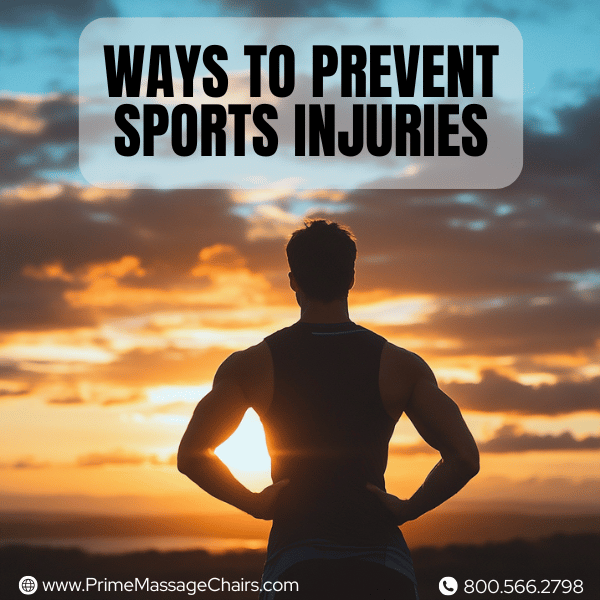
Ways to Prevent Sports Injuries: Tips you Need to Try!
Understanding the best ways to prevent sports injuries may help athletes stay active and injury-free.
This article shares ways to potentially prevent sports injuries.
Keep reading to stay informed!
Importance of Preventing Sports Injuries
Avoiding sports injuries could be critical for maintaining health.
Nearly 30 million kids may participate in organized sports each year, potentially resulting in about 2.6 million injuries that require serious medical care, according to the Centers for Disease Control and Prevention (CDC).
While the CDC provides statistics on sports-related injuries, a specific reference to these figures could be found in their report on injury rates: CDC Sports Injury Rates.
Emergency rooms may see more than 1.35 million visits annually for sports-related injuries.

Many of these injuries could happen because players may potentially not wear the right safety gear or they train too much without adequate rest.
Guidelines from the National Athletic Trainers' Association (NATA) emphasize the importance of using proper protective equipment and balancing training with rest to potentially prevent such injuries.
For more details, see the NATA Injury Trends and Prevention Fact Sheet. Poor training methods, like using the wrong form during activity, may also contribute to injuries.
Simple steps such as wearing helmets in baseball or mouth guards in football could reduce risks.
Preventing injuries may help young athletes continue playing their favorite sports safely.
This focus on prevention could benefit everyone involved – from soccer players to track sprinters – by reducing unnecessary trips to healthcare providers and keeping bodies ready for action.
Disclaimer: Always consult with a qualified medical professional for personalized advice related to sports injuries and prevention strategies.
Warm-Up and Cool-Down Routines
Starting your workout with a warm-up may help prepare your muscles. Stretching and light jogging could get you ready for more intense activity.
After you're done, cooling down with gentle stretching may help slow your heartbeat and relax your body.
This approach could help you ease into and out of heavy exercise more safely, potentially reducing injuries.
Benefits of Warming Up Before Activity
- Warming up before any physical activity may help prevent injuries. It could make your muscles warm and more flexible, allowing for easier movement with less chance of injury.
- Activities like jumping jacks may increase blood flow and prepare your body for strenuous exercise.
- By doing a proper warm-up, you may avoid common sports injuries such as sprains or muscle tears.
- Think of it as getting your car ready for a long drive; warming up could get your body in better shape to perform well and stay safer during exercise.
Importance of Cooling Down After Exercise
Just like warming up may prepare your body, cooling down after exercise could help your body slow down in a safer way.
After intense activity, your heart rate may be high, and your muscles may feel tight.
A cool-down phase may prevent blood from pooling in one place and causing cramps or dizziness. It’s a smooth transition back to a resting state.

Stretching exercises during this time could improve muscle flexibility, potentially reducing the risk of injuries later on.
Each stretch should last between 20-30 seconds for optimal effects on the muscles.
Cooling down may be as important as warming up for maintaining safety during physical activities.
Disclaimer: Individual results may vary. Consult a fitness expert for guidance tailored to your needs.
Proper Equipment and Gear
Wearing the right outfit and tools could play a big part in staying safe while playing sports.
This means choosing gear that fits well, such as helmets for biking or pads for football, and ensuring your shoes support your feet correctly.
Choosing the Right Protective Equipment
Using appropriate protective gear may help reduce injuries in sports.
This includes helmets, face guards, mouthpieces, shoulder protectors, and more. All equipment must fit properly.
A helmet that’s too big may not protect your head well. Mouthpieces could guard against dental damage. Shoulder protectors may help keep your upper body safer.
Ensuring Proper Footwear
Choosing the right shoes could be vital for avoiding sports injuries.
Your shoes should fit well and offer strong support for your feet. This may help prevent issues that could lead to pain or injury during activities.
For instance, runners may need shoes designed to handle the impact of repeated foot strikes on the ground. These differ from shoes a soccer player might wear on the field.
Always use proper footwear to potentially reduce your risk of injury. It’s not just about comfort—it’s also about safety.
Change your sports shoes often enough. Worn-out shoes lose their ability to protect your feet and absorb shock effectively, which may increase your risk of injury.
Disclaimer: Consult a footwear specialist or podiatrist for specific recommendations based on your activity and foot type.
Strength and Conditioning
Strength and conditioning could play a significant role in preventing sports injuries.
By focusing on building muscle strength and learning proper movement techniques, you may protect yourself during activities like running or soccer.
Incorporating Strength Training
Strength training may help reduce the risk of sports injuries.
Experts from the American Orthopaedics Society for Sports Medicine suggest incorporating strength exercises 2-3 times a week to enhance core, leg, and arm muscles.
For effective results, choose exercises that target multiple muscle groups. Use weights that challenge you without causing pain. Proper form may prevent overuse injuries, which are common in sports.
Core Muscle Exercises for Injury Prevention
Strengthening your core muscles may reduce the likelihood of injuries by improving stability and balance.
Exercises like planks, bridges, and leg lifts could support your spine and pelvis, making your body more resistant to injury.

By incorporating core exercises into your fitness routine, you may protect joints and muscles while enhancing overall strength and endurance.
This focus on core strength could also improve performance and reduce fatigue during sports.
Disclaimer: Consult with a certified trainer or physical therapist to ensure proper technique and a personalized training plan.
Proper Techniques and Form
Using correct posture and movement techniques may be essential to reducing strain and avoiding injuries during sports.
Emphasizing Correct Posture and Movements
Learning the right way to move and hold your body during activities could lower the risk of stress-related injuries.
Working with a knowledgeable coach or trainer may help you develop proper form and avoid repetitive strain on specific joints or muscles.
Avoiding Overuse of Specific Body Parts
Overusing the same muscles or joints repeatedly could lead to conditions like tendinitis or stress fractures.

Mixing up your workouts may allow different muscle groups to recover, potentially lowering the risk of overuse injuries.
Nutrition and Hydration
Eating the right foods and staying hydrated may be key to preventing sports injuries.
Eating for Muscle Recovery and Strength
Consuming a balanced diet that includes adequate protein may support muscle recovery and strength.
Foods like chicken, fish, eggs, and beans provide essential nutrients for repairing tissues and maintaining energy levels.
Staying Hydrated During Physical Activity
Drinking enough water before, during, and after exercise could help prevent dehydration, which may lead to cramps and fatigue.
Monitor your hydration levels and adjust based on activity intensity and environmental conditions.
Disclaimer: Consult with a nutritionist or healthcare provider for personalized dietary recommendations.
Massage Chairs and Sports Injury Prevention
Massage chairs could play a role in reducing the risk of sports injuries by potentially promoting muscle relaxation and improving circulation. Using a massage chair may help relieve muscle tension and stiffness, which could lower the likelihood of strains or overuse injuries.
How Massage Chairs May Help
-
Muscle Relaxation: Regular use of massage chairs could help reduce muscle tightness, especially after intense physical activity. Relaxed muscles may be less prone to injuries such as sprains or strains.
-
Improved Circulation: Massage therapy provided by these chairs may promote better blood flow to muscles and joints, which could enhance recovery and reduce soreness after workouts.
-
Stress Relief: Reducing overall stress levels may indirectly contribute to injury prevention, as it could improve focus and performance during sports activities.
While massage chairs may offer potential benefits, they should not replace traditional recovery methods like stretching, hydration, or rest. Always use them as a complementary tool to your existing routine.
Disclaimer: Consult with a healthcare provider before incorporating massage chairs into your recovery plan, especially if you have existing medical conditions.
Rest and Recovery
Rest and recovery may play a crucial role in maintaining overall physical health and preventing injuries.
Importance of Rest Days
Scheduling regular rest days may give your body time to heal and rebuild.
Overtraining could lead to exhaustion and increase the risk of injuries, such as stress fractures or muscle strains.
Listening to Your Body for Signs of Overtraining
Pay attention to warning signs like persistent soreness or fatigue, which may indicate the need for more rest.
Ignoring these signals could result in serious injuries that require medical attention.
Disclaimer: Always consult with a healthcare provider if you experience ongoing pain or discomfort.
When to Seek Medical Advice
Recognizing when to seek medical care may prevent minor injuries from becoming serious.
Recognizing Serious Injury Symptoms
Seek immediate medical attention for symptoms such as severe pain, swelling, visible deformities, or excessive bleeding. Delaying care could lead to complications.
Consulting a Sports Medicine Specialist
Sports medicine specialists may help diagnose and treat sports-related injuries.
They could also provide guidance on preventing future injuries and creating a safe return-to-play plan.
Disclaimer: The information in this article is for general purposes only and should not replace professional medical advice.
FAQs
What Are the Top Strategies for Preventing Sports Injuries?
Top strategies include warming up and cooling down properly, wearing the right equipment, and incorporating strength training.
Always consult a medical professional for tailored advice.
How Can I Reduce the Risk of Knee Injuries?
To reduce the risk of knee injuries, use proper protective gear and practice exercises that strengthen your leg muscles.
Consult a trainer or physical therapist for additional guidance.
Can Overtraining Lead to Injuries?
Yes, overtraining may increase the risk of injuries like stress fractures and muscle strains. Incorporating rest days and listening to your body are key.
How Does Hydration Affect Injury Prevention?
Proper hydration may prevent muscle cramps and fatigue, reducing the risk of injury. Drink water before, during, and after exercise based on your activity level.
When Should I See a Doctor for a Sports Injury?
You should see a doctor if you experience severe pain, swelling, visible deformities, or persistent discomfort. A sports medicine specialist may provide the best care for such issues.
Conclusion
Learning the right ways to prevent sports injuries may ensure you could enjoy sports safely and confidently.
Preventing sports injuries may require a combination of proper preparation, equipment, and recovery strategies.
Warm-ups, cool-downs, strength training, and adequate hydration could all play a role in reducing injury risks.
Using the right techniques and listening to your body are equally important for staying safe.
By following these tips and consulting professionals when needed, athletes of all ages may enjoy their favorite sports while minimizing potential harm.
Always prioritize safety to ensure long-term health and performance.
Disclaimer:
We do not provide medical advice. The content of this article, including text, graphics, and other material, is for informational purposes only. It is not intended to be a substitute for professional medical advice, diagnosis, or treatment. Always seek the advice of your physician or other qualified health provider with any questions you may have regarding a health condition. Never disregard professional medical advice or delay in seeking it because of something you have read in this article or on our website.
